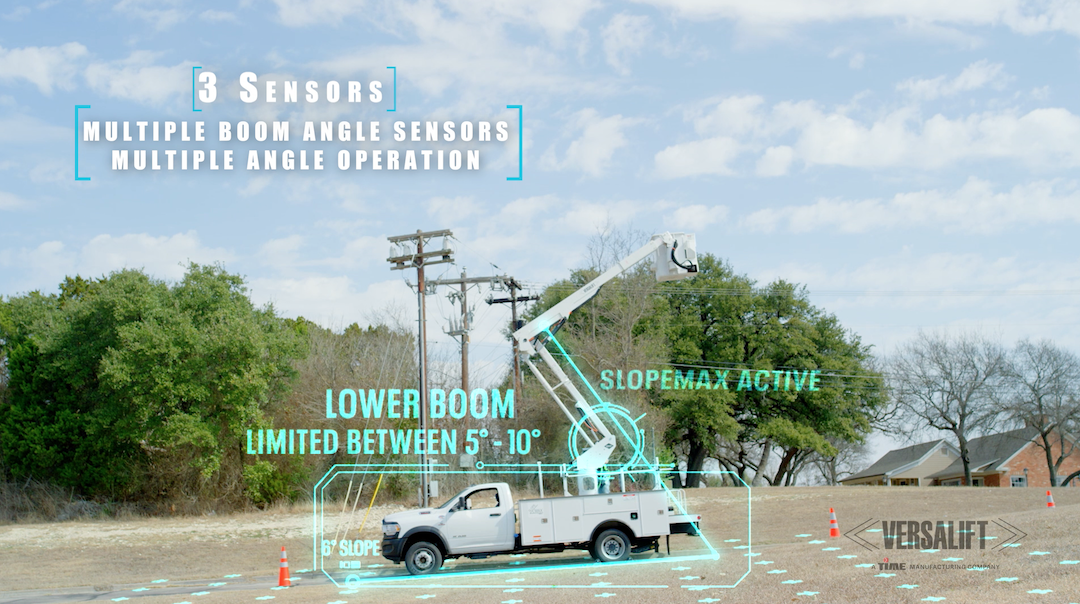
Bucket Truck Overturn
Safety System
SlopeMax Bucket Truck Overturn Safety System provides safer working conditions for aerial lift operators and other technician around the truck. This innovation measures the slope angle of the surface and boom, and limits the horizontal reach via the lower boom function whenever it is necessary. This allows full operation of the boom without the worry of reading inclinometer gauge as the boom control and limits will be automated making the lineman’s job easier and safer.
Bucket Truck Safety System – SlopeMax
Bucket Truck Safety System – SlopeMax is a passive operating system that provides safer working conditions for aerial lift technicians. This innovation measures the slope angle of the surface and boom, and limits the horizontal reach via the lower boom function whenever it is necessary.
Aerial Lift Safety System – SlopeMax is the newest Versalift engineering innovation that allows technicians to work in safer conditions without the need to constantly check slope angle indicators. This example underscores the culture of innovation and safety at Versalift, and all Time Manufacturing Company brands.
Bucket Truck Safety System – SlopeMax a Smarter Solution for Safer Operation on Uneven Surfaces
Bucket Truck Safety System – SlopeMax is an innovative passive safety system that improves both operator safety and job site efficiency. The advantages of SlopeMax will be felt most by fleets and contractors that operate in hilly and mountainous areas, where the slope of the job site exceeds five degrees. SlopeMax by Versalift increases your productivity, and it decreases any operator’s capacity to use a bucket truck in an unsafe or illegal way.
Bucket Truck rentals create a compelling reason to have a passive on-board safety system as it improves safe working envelopes regardless of the training and expertise of the operator.
Aerial Lift guidelines by ANSI have until recently officially recommended that bucket trucks be limited to working on slopes of up to five degrees. This limitation served to make technicians safer, and to prevent tip-overs and other serious accidents. Newly updated ANSI A92.2 aerial lift standards simply state that operators should follow the direction of manufacturers, and with SlopeMax, Versalift makes it safe to operate on a base slope of greater than five degrees. Until SlopeMax, there has not been a way to safely operate a bucket truck on steep hills or uneven terrain, where slope is greater than 5 degrees. Now operators can operate on slopes of five to ten degrees, albeit with a reduced lower boom function in some cases. SlopeMax is available on several Versalift SST and VST models.
Aerial Lift Safety System – SlopeMax – Technical Explanation
Bucket Truck Safety System – SlopeMax is a passive system of sensors that keeps operators safer by measuring the slope angle of the surface and boom, and by limiting the horizontal reach via the lower boom function whenever it is necessary. This allows work to be completed in rougher and more uneven terrain.
-
Aerial Lift Safety System – SlopeMax is a system of angular sensors that are located to measure the aerial base angle and lower boom angle relative to horizontal. The system limits the operating envelope depending on the aerial lift base angle.
-
Aerial Work Platform Safety Systems measure the base angle within 5 degrees (or predetermined angle depending on aerial lift model) of horizontal, the aerial lift is allowed to operate to its full envelope range.
-
Aerial Lift Safety Systems like SlopeMax, protect the operator when the base angle exceeds 5 degrees (or predetermined angle depending on bucket truck model) above horizontal, the structural, functional, and overturning stability limits may be exceeded when the lift platform is at a maximum horizontal position.
-
To prevent this the lower boom maximum raised position is limited, which will reduce the horizontal position and thus reduce loading due to horizontal position below the aerial lift maximum load limits.
-
If the base angle exceeds a maximum-operating angle, the lower boom raise (elevate) function will be disabled and not allowed to raise from its stowed position.
-
The sensors are part of a control system that will control the hydraulic limit of the lower boom.
